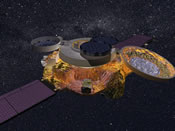 |
| Artist Rendering
of Spacecraft in Collection Configuration |
When Genesis' solar arrays were extended in space, the
Genesis spacecraft resembled an unbuckled wristwatch.
The watch's face is the science deck, and the figurative
straps are the opened solar panels. The framework of the
spacecraft is composed mostly of graphite fiber composite,
aluminum and some titanium. Using titanium is an efficient
way of conserving mass while retaining strength. Genesis'
composite structure is similar to that used in the construction
of high-performance aircraft. The spacecraft incorporates
innovative, state-of-the-art technologies pioneered by
other recent missions using off-the-shelf spacecraft components
and, in many cases, spare parts and instrumentation left
over from previous missions. There are a total of eight
payloads making up the four science instruments on Genesis
— the three specialized collector arrays; the two
bulk collector arrays; the concentrator; the ion monitor;
and the electron monitor. Spacecraft instruments are designed
to meet a mission's science goals. These instruments will
help scientists understand the origin of the solar system.
Media contact:
D. C. Agle, Jet Propulsion Laboratory, (818) 393-9011
|
